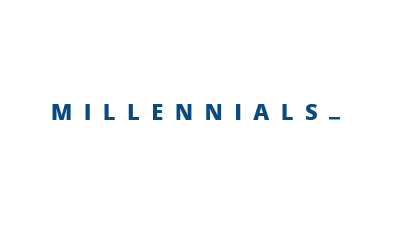INTRODUCTION
Society is increasingly digitalized. The continuous use of new digital devices places greater demands on our visual capacity. Nowadays, digital screens are not only found in the domestic sphere, but also in the educational environment. As a result, their excessive, prolonged and inappropriate use increasingly affects all ages, especially the digital youth.
Such extensive use of digital screens in near vision causes visual stress or fatigue to the user. This is especially true for Generation Y, also known as MILLENNIALS, because they came of age at the turn of the millennium. MILLENNIALS are mass users of computers, tablets, smartphones and other devices in the digital age. All of this leads to generalized ocular discomfort, especially eye strain, which is all the greater because when using handheld devices, we hold them at a very close distance from the eye.

Image 1: Generations timeline.
According to a study by The Vision Council, 32% of adults experience ocular fatigue and 27% experience dry eye, headaches and blurred vision while using electronic devices. Globally, around 60 million people in the world suffer from some kind of visual problem associated with the use of digital screens. (1)
THE EFFECT OF EYE STRAIN WITH AGE
As the years go by, it becomes more difficult to focus on objects with maximum definition as presbyopia emerges. The typical sign of presbyopia is difficulty reading up close, usually at distances of less than one meter. The age of onset of presbyopia depends on: the person’s accommodative capacity, usual near working distance, near visual demand and, primarily, refractive error.
Although presbyopia usually appears around the age of 40, a person whose occupation requires accurate near vision will notice symptoms of presbyopia very early. However, someone who does not use their eyes for accurate near vision will not notice it until they encounter difficulty, for example, when reading the newspaper. The thing is, new digital devices require very short working distances. This causes eye strain, that is, the early appearance of symptoms associated with presbyopia.
Users under the age of 40 who present presbyopia-related symptoms due to the intensive use of near vision are known as pre-presbyopic users.
Additionally, there are studies that show that OLED light from digital devices impacts melatonin production. This is the hormone responsible for regulating the circadian sleep cycle. (2)
As already mentioned, the onset of presbyopia also depends on the person’s refractive error in distance vision and the type of correction they use. This is mainly because a myopic eye and a hyperopic eye are anatomically different:
- The myopic eye is “longer”, the image of a distant object is formed in front of the retina, causing blurred vision, and the image of a near object is brought closer to the retina, improving vision.
- The hyperopic eye is “shorter”, the image of a distant object is formed behind the retina and the image of a near object is moved further away from the retina, making it more difficult to see.

Horizons Optical presents MILLENNIALS, the visual solution for the hyperconnected generation. MILLENNIALS promotes comfortable vision during the intensive use of devices. Specifically:
- It takes into account the current near vision needs and the prescription (refractive effect) of each person.
-
- MYOPIC EYE: Thanks to the excess power in near vision, ocular effort is less. That is why eye strain appears at a later age than in other users.
-
- HYPEROPIC EYE: Even if you wear glasses, your natural condition will be a lack of power in near vision, which increases ocular effort and leads to eye strain.
Considering the prescription and age of the user, the MILLENNIALS design offers the right near vision aid to easily focus on objects

Image 2: Near vision reinforcement is established based on the user’s prescription, age and amplitude of accommodation.
Additionally, MILLENNIALS provides sharp, comfortable vision to digital users thanks to advanced Optimesh technology that compensates for the user’s position of wear.
- Point-to-point surface optimization: Sharpness & Personalization.
- Side distortion is eliminated: Comfort.
2. It consists of a technology that blocks excess OLED blue light from digital devices. MILLENNIALS protects from the most powerful wavelength of all those emitted by the latest generation of phones: 460 nm.

Image 3: Representation of wavelenghts.
RECOMMENDATIONS FOR THE OPTICIAN – OPTOMETRIST
It is recommended to perform a complete visual examination taking into account:
- The patient’s anamnesis (must contain information on the times and type of digital device that they normally use)
- The refractive state in distance vision
- The refractive state in near vision
- Binocular vision
- The accommodative system.
In this way, the optician will ensure that the low addition will be perfectly accepted by the user.
At the end of the examination, regardless of the method used, a clear vision pathway test should be performed and ensure that the person’s visual needs are met.
It is advisable to explain to the patient that presbyopic symptoms are the start, and that comfort in near vision will improve with the new prescription, but that after a few years the initial symptoms in near vision may return and a new prescription with a little more power will be necessary using a progressive addition lens.
CONCLUSIONS
MILLENNIALS is the only anti-fatigue design on the market that takes into account the patient’s refractive status to recommend additional near vision correction.
It is recommended from the age of 25, when the amplitude of accommodation begins to suffer a significant decline.
In addition, MILLENNIALS takes into account the user’s position of wear compensation to obtain the necessary correction at each point of the lens for the user in question.


